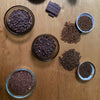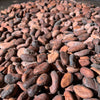About The Alto Beni Region
These are out of the Alto Beni region of Bolivia. I find it terribly interesting how different the flavor profiles are given similar genetics but different cultivation and fermentation procedures. When I asked about the background of this cocoa, this story unfolded. I really supporting this and I hope you do too.
"I was running a B2B project in 2009 to develop fine flavor cacao protocols for boutique chocolate in Denmark. To get there we started from the ground and built a state of the art cacao centre in 2009 (Flor de Cacao) and worked only with selected producers in Alto Beni. The first production was right away successful in Paris at the International Cocoa Awards. In 2014 our Alto Beni cacao reached HCP (Heirloom Cacao Project) status.
"Unfortunately we had to shut down Flor de Cacao in 2015 due to lack of funding, high cocoa prices and production collapse caused by Monilla. The plant went into dormancy for 8 years. Last year I was able to reopen the plant and renew the contacts to the farmers, some already over 70 years old. "The genetic cacao pool in Alto Beni, based on old trinitario varieties, has been continuously evolved since the 70'ties as many farmers believed that only a seed can produce a tree. In Peru and Ecuador CCN51 clones became the panacea. In Alto Beni, entirely unnoticed from International Aid projects, the people and their organizations overcame the Monilla crisis applying a local selection process of local elite varieties. The cacao you have is the result of the efforts to preserve genetic diversity thanks to the persistence of smallholder farmers in Alto Beni."Our best farmer, Felix Paredes (74) has selected 8 well producing local clones for his 3 hectare farm. This year I have made a special edition of Felix Paredes cacao that will be presented through HCP for its upcoming 10th anniversary in 2024."









